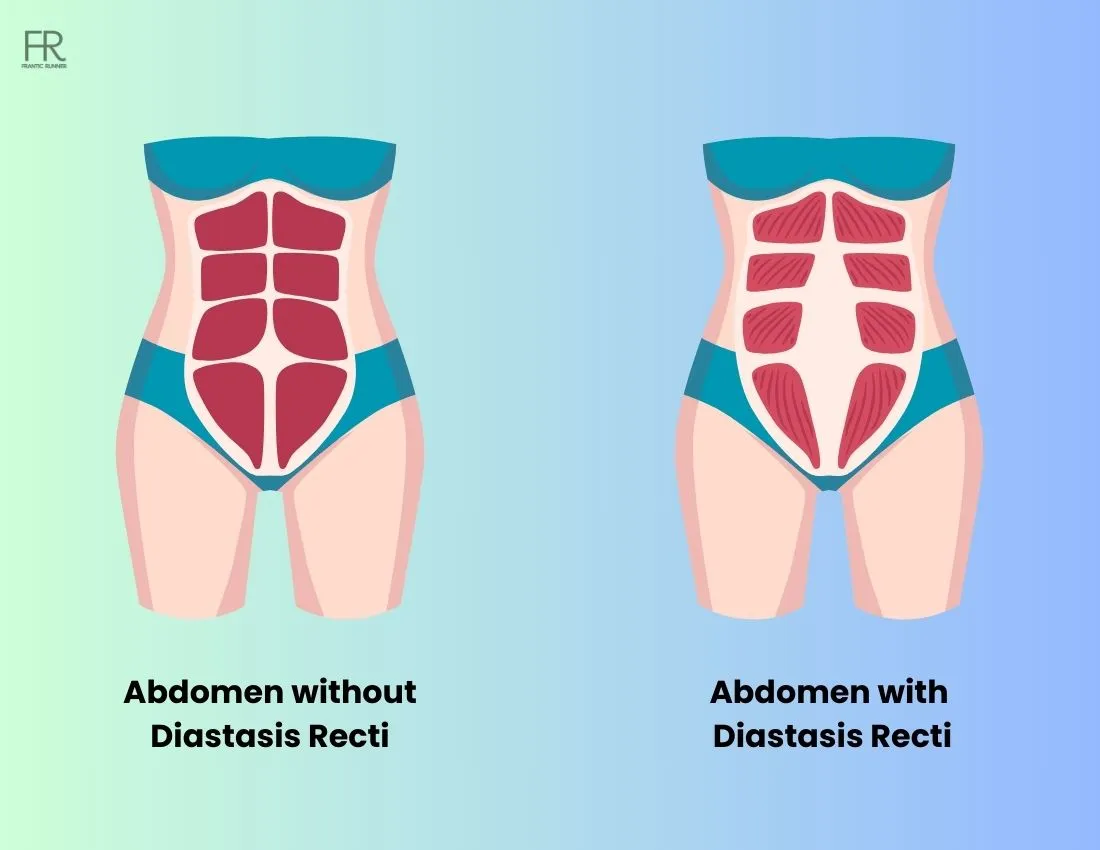Running with Diastasis Recti
(Must-know Facts + Safety Tips)
It is not advised to run with Diastasis Recti. Running miles and miles can worsen your disease if you lack good running tips. If you do not do any strength training after birth, it means your abdominals and pelvic floor are still weak. Cardiovascular endurance, strength training, good posture, and diaphragmatic breathing can prevent it.
This blog will share important information about running with Diastasis Recti. We will give tips on how to prevent it, safe exercises to do, and how to prioritize body mechanics. This will be helpful for women looking to manage this condition.
What is Diastasis Recti?
Diastasis Recti Abdominis is a very harmful disease in runners. It separates the rectus abdominis muscle, thinning along the center of the muscle at the Linea alba.
It occurs in heavyweight lifters, pregnant women, and those who are so dynamic with core exercises. It is most expected during pregnancy due to the big belly, muscles weaken, and the uterus expands.
The study found a high prevalence of mild Diastasis Recti Abdominis (DRA) during and after pregnancy. And with no evident risk factors or significant difference in lumbopelvic pain between those with and without DRA postpartum.
Heavy lifting ≥20 times weekly was linked with a greater possibility of DRA (OR 2.18, 95% CI 1.05 to 4.52). At the same time, there was no significant difference in reported lumbopelvic pain (p=0.10) among women with and without Diastasis Recti
Should You Run With Diastasis Recti?
Starting a running routine week postpartum is important. However, your post-baby body has many essentials like core healing and pelvic floor reshaping.
Related Article: “Why Is Running So Hard For Me? (15 Easy Tips For Beginners)”
Consider addressing this issue before you can begin running. If you are suffering from Diastasis Recti (DR) then it is crucial to know what this is and if can you run with it.
The answer to the common question, “Can I run with a Diastasis?” is no. If you have severe pelvic floor dysfunction then running can make your condition worse. If you don’t know good running tips and skip strength training after pregnancy, it’s best to avoid running to prevent injury.
How Movement Mechanics Impact Diastasis - The Wrong Moves
- If your head comes forward while running, it is not a favourable movement for Diastasis recti. Similarly, if your shoulders hunch, it may aid to the worsening of this disease.
2. Sometimes, the bottom tucks under or sticks way out during exercise, it’s not ideal for Diastasis Recti management. Be mindful of your posture to minimize strain on the abdominal muscle.
3. In pregnancy, ribs expand with the growing baby. You find yourself gripping them down. These moves can potentially worsen your DR or even cause pelvic pain. So, focus on maintaining a balanced and supportive posture for progressive running.
Related Article: “Can Running Increase Height? (7 Useful Ways To Achieve It)“
4. A slight forward lean with a cheetah-like gait (regardless of speed) can impact your Diastasis Recti. Pay attention to your running posture to avoid unnecessary stress on the abdominal area and enhance support for healing.
Prevention Tips for Diastasis Recti
-
- Practice the log roll maneuver during pregnancy when standing up from the couch or floor. Roll onto one side with your torso and head aligned, then use your arms to assist in pushing yourself up to a sitting position.
-
- Engage in Diastasis Recti-safe exercises during pregnancy. Focus on bolstering the deep core muscles. Explore some physical therapy-tailored exercises to get better.
-
- Consider including exercises to prevent and repair Diastasis Recti while supporting overall fitness during and after pregnancy.
-
- Prioritize proper body mechanics, while maintaining a good position. Avoid movements that push the abdominal muscles.
Conclusion
This article explains the must-know facts for running with Diastasis Recti and important safety tips. Running with it requires careful consideration. Women must understand Diastasis Recti Abdominis (DRA) risk factors during and after pregnancy.
Understanding the impact of movement mechanics on Diastasis Recti highlights the importance of maintaining proper posture. Read and explore Diastasis Recti Exercises: 25 easy-to-follow workouts. Let’s fix your abdominal separation, strengthen the core, and eliminate belly bulge. Happy Healthy Life!
Frequently Asked Questions (FAQs)
Yes, you can but only low impact like swimming and slow cycling. Brisk walking is the best cardio for Diastasis Recti. During postpartum, females gain weight. So, walking is the best activity for them.
Avoid holding your breath during exercise, reverse curls, planks postpartum, crunches, oblique curls, sit-ups, and roll-ups until healing. Refrain from any workout that includes muscle bulging.
Do strength exercises 3-4 times a week to improve diastasis recti gap and pain within 6-8 weeks. Be consistent for better results. If you do not feel any progress after 4 weeks, seek guidance from a certified physical therapist
During each exhalation, contract your abdominal muscles, pulling them upward and inward towards the spine to safeguard your core. Subsequently, as you inhale, release allowing your belly to soften and relax.


